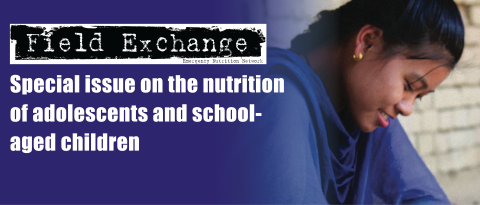Case Study 1: Assessing effectiveness of an interactive magazine aimed at influencing nutrition behaviours among school-attending adolescents in Timor-Leste
By Sarah Meyanathan, Kristine Larsen and Lindsey Pexton
Sarah Meyanathan worked with Mercy Corps for four years on the TOMAK project. She has an anthropology background and has worked extensively on maternal and child health programmes in Timor-Leste.
Kristen Larsen works with Adam Smith International as a Monitoring and Evaluation Adviser. She has a public health background and has worked on maternal and child health programmes in Timor-Leste for over five years.
Lindsey Pexton is Mercy Corps’ Senior Nutrition Adviser based in the UK. Prior to joining the Mercy Corps’ global team two years ago, she worked as a roving Nutrition Cluster Coordinator for the Global Nutrition Cluster (GNC).
Background
Despite representing over 25% of the population in Timor-Leste, adolescents have historically been neglected in national nutrition data and programming. However, existing data indicates that, based on their nutrient needs, the diets of adolescent girls account for 45% of the dietary cost of households, more than any other family member. Thus, only one in four households in Timor-Leste are estimated to be able to afford a diet that meets the nutrient requirements of adolescent girls (World Food Programme, 2019). Recently, due to an increased global focus on the nutrition of adolescents, there has been growing interest in this critical life stage in Timor-Leste. In 2019, the To’os Ba Moris D’iak (Farming for Prosperity) programme (TOMAK) collaborated with Adam Smith International and Mercy Corps to test whether an interactive magazine developed for adolescents 10-19 years of age is an effective approach to improve the dietary behaviours of adolescents in schools.
Formative research conducted by TOMAK and the World Food Programme (WFP) in 2018 revealed that adolescents in Timor-Leste trust what they read in CARE’s Lafaek educational magazine. The well-known magazine is distributed nationally through schools, targeting primary school children and their communities. As a result of the formative research findings, TOMAK, WFP and CARE collaborated on a Special Edition Lafaek magazine that focused primarily on nutrition-related behaviours that are within adolescents’ control, including:
- The selection of healthy and balanced snacks at school
- Selection of water as the healthiest drink choice
- Consumption of breakfast before going to school
Whilst formative research was critical in identifying these key adolescent nutrition behaviours, additional concept testing of different versions of the magazine was required to understand what and who adolescents perceived to be ‘cool’ and ‘fun’. This was an essential component of developing a magazine that would effectively engage adolescents.
To accompany the magazine, TOMAK also developed a series of three, two-hour facilitated nutrition sessions. The sessions were led by programme staff and used the magazine content as interactive tools (e.g., stories and games) to encourage adolescent action planning. The session pack included a facilitator guide and checklist to ensure consistent, high-quality delivery of the sessions.
The effectiveness of the magazine as a standalone tool compared to its use in conjunction with in-person nutrition sessions was assessed in 270 students from four high schools between August and December 2019. A pre/post-test questionnaire was administered to samples of adolescents who either participated in the nutrition sessions using the magazine or who only received the magazine at school.
Results
The results of the pre-post tests showed that students’ understanding of nutrition topics improved in both study groups (nutrition sessions + magazine (NS) vs. magazine only (MO)). Based on the percentage of correct answers from pre- to post-tests, students developed a greater understanding of the importance of eating a wide variety of foods (7% to 71% for NS vs. 12% to 99% MO), water being the healthiest drink option (57% to 100% NS vs. 60% to 74% MO) and the benefits of eating a healthy breakfast (70% to 94% NS vs. 66% to 78% MO) and healthier snacks (43% to 78% NS vs. 53% to 57% MO). Self-reported consumption of sweetened drinks decreased from pre- to post-test (33% to 7% NS vs. 20% to 12% MO). Adolescents also demonstrated greater confidence in their abilities to positively influence the nutrition practices of their peers (30% to 55% NS vs. 46% to 64% MO). Overall, the study showed a greater impact in the group that received nutrition sessions alongside the magazine, allowing for further engagement around key nutrition practices and strengthening adolescents’ confidence and ability to change their own behaviours and to influence peers.
Next steps
Testing the magazine’s content and evaluating the impact of the tool facilitated the development of a high-quality product and demonstrated the effectiveness of the standalone interactive magazine (TOMAK, 2021). The evaluation also contributes to discussions on the pay-off between participant reach and impact since the effects were greater when the magazine was combined with face-to-face interactions.
For more information, please contact Sarah Meyanathan at Sarah.Meyanathan@tomak.org
References:
World Food Programme (2019) Fill the nutrient gap, Timor-Leste. Final Report. Available at: https://www.wfp.org/publications/fill-nutrient-gap-timor-leste
TOMAK (2021) Resources. Accessed at: http://tomak.org/resources/


 English
English Français
Français Deutsch
Deutsch Italiano
Italiano Español
Español